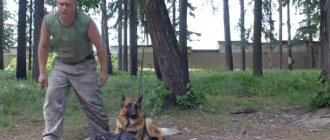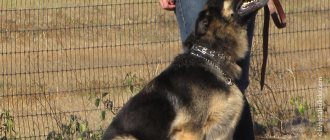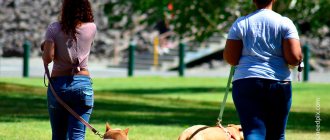It’s not at all difficult to train a dog to a place, you just need to be a little patient. In general, the dog should have its own place. And she should go there not only when she wants to sleep or relax. She must also occupy it at the first request of the owner.
If you have a four-legged friend, then get ready for the fact that you will constantly need to be responsible for him. You will have to educate him, play with him, look after him, and so on. In general, part of the time that you are used to spending, for example, at the computer, will now have to be devoted to it.
Mokhnatyk, once in your house, was separated from the friendly crowd of his brothers and sisters. Therefore, at first it will not be easy for him. He will undoubtedly be greatly missed and suffered. You should surround him with as much care and affection as possible. After all, now he has no one except you.
It all starts with arrangement
Place training for dogs begins with arranging a personal space. The chosen corner should be comfortable and safe. Otherwise, the pet may refuse to go there.
Choosing a corner in the house
A dog's corner is an inviolable territory that should be associated with complete safety for the pet. During sleep and rest, try not to disturb the animal unnecessarily and convey this information to your children.
In addition to close contacts, the four-legged animal will have to be protected from noise and drafts. When choosing a corner for him, avoid the space directly under windows and next to heating devices, as well as being too close to a TV or stereo system.
You should not give preference to the living room if children often play there or your friends gather there. The same applies to the kitchen, where household appliances are constantly running.
The sun lounger should have a good view, but this does not mean that it should be placed on the aisle.
“
The best option is next to the wall or right in the corner of the room.
This arrangement will give a feeling of security, since no one will be able to sneak up on a sleeping dog unnoticed.
Buying a bed and other things
Having figured out the location, feel free to move on to arranging the chosen place. A proper dog bed must meet the following criteria:
- High quality material
. Focus on softness, durability and ease of care. Beddings get dirty quickly, so give preference to models with replaceable covers.
- Hypoallergenic
. The likelihood of allergic reactions will be lower if you take a product made from natural materials that are not electrified. One such material is twigs, but wicker baskets have many disadvantages, including fragility.
- Matching "user" parameters
. Consider not only the size of the dog (length from nose to tip of tail), but also its favorite poses. If your pet sleeps in a ball, then a round or oval shape with sides will suit her, and if with elongated legs, then a rectangular shape. Be sure to add another 15-30 cm to the body length.
In addition to the bed, you should put your pet’s toys and any soft things with your scent (an old T-shirt or sock) in the corner. The former will be useful for leisure, and the smell of the latter will create a cozy and peaceful environment.
Defining tasks
The hardest part about finding a special place for your dog to sleep each night can be choosing the right spot. Unless you plan on having your dog sleep in your bedroom with you, even if not in your bed, you need to choose a place where he will feel safe and comfortable away from you.
Sleep training for dogs is mostly about time and repetition. He will want comfort and security all night long. Creating a repeating routine for this sleep-only space is essential to teaching him where he needs to be when it's time to go to bed.
The second most important thing in training your dog to know where to sleep each night is to provide him with a comfortable bed that he will want to stay in all night. This means you can change beds as they grow and also know how your dog sleeps. For the first few nights, you can start with your dog on a folded blanket on the floor.
If your dog sleeps curled up, he may need a small bed with raised sides to ensure safety and comfort. If your dog sleeps spread out, he will be uncomfortable in a bed with high sides, but he may prefer a larger bed that can accommodate his longer body.
© shutterstock
At what age should a puppy be taught his place?
You need to start training immediately after the baby moves into your home, that is, at 2-3 months. After getting acquainted with new smells and unusual surroundings, the new resident needs to be fed and taken to a pre-prepared corner.
Don't delay with the toilet either. Tired of games and a hearty lunch, the puppy will most likely want to relieve itself. To avoid an incident, first of all you should put him on a diaper and only then take him to the lounger. Otherwise, there is a risk that the last one will be mistaken for a toilet.
How to make a dog fall asleep
If proper preparation for bed is carried out, the puppy will not bother the owner until the morning. Before going to bed, it is important to give your pet the opportunity to relieve itself.
For better absorption of food, it should be fed several hours before bedtime. If anxiety arises and to show concern, you can give your pet a massage with light strokes. Before you put the puppy to sleep, you need to give him a good walk with the maximum expenditure of his strength.
If you don’t know how to put your dog to sleep, you can consult a veterinarian. Experts sometimes recommend taking antihistamines to help the dog calm down for the first time before he gets used to the new regime.
Basics and rules of training
After settling in, you can move on to actual training. When choosing a training method, be guided by the age of your pet.
Puppies
Puppies are rarely a problem if you remember to handle them. Their training is structured as follows:
Wait until the baby gets tired. Despite the hyperactivity, the charge in puppyhood is consumed very quickly.
Take your pet to the bed and say the command “Place”. Be sure to praise the four-legged animal if it does not run away. To reinforce positive associations, you can give out a treat or a new toy.
When escaping, repeat the previous step. Do not try to hold your baby in the bed by force. He must stay there of his own free will.
If the baby is guilty and lies down in his place, try to refrain from lectures.
Important!
Punishments in an animal's territory are unacceptable. They undermine the feeling of security and cause disgust in front of the bed.
Repeat the exercise 3-6 times a day until the skill is consolidated. On average, this takes 1-2 weeks. As a result, the puppy should learn to go to its place immediately after the command without being accompanied by the owner.
Adult dogs
When it comes to training adult dogs, everything is much more complicated. Unlike puppies, they have an already formed behavior model. Because of this, they need to not only be taught new things, but also weaned off old ones.
The training algorithm looks like this:
- Call your pet and wait for it to come to you.
- Go with your dog to the lounger and command “Place.” If he refuses to walk on his own, use a leash.
- Place a toy in front of the lounger and do not let him take it. At this stage, move away from your pet by the length of the leash.
- Reward the animal with affection, praise and treats if successful.
- Wait a few minutes and call your pet back to you. Take a break from playing or practicing other exercises, and then repeat the previous steps again.
Gradually increase the distance between the bed and the toy so that eventually the dog waits for your return without using additional tricks.
What do you prefer to feed your pets?
Poll Options are limited because JavaScript is disabled in your browser.
- Porridge with various additives 46%, 8368 votes
Dry food only 26%, 4710 votes
In everyday life, sometimes you have to give your pet the command “Place!” so that he calms down and goes to his bed. Usually it is served when a pet behaves badly, interferes, or pesters. It is recommended that you first learn the “Down!” command.
Training begins by arranging the animal's sleeping place, which should be cozy, soft and surrounded by toys. A quiet corner, protected from drafts, is allocated for the sleeping area. The baby is introduced to his personal lounger, allowed to sniff and taste it.
What to do if your pet does not want to go to the place
Having figured out how to train a puppy or adult dog to sit, immediately move on to practice. Despite the simplicity of the theoretical part, training does not always go smoothly. The pet can be stubborn for a long time and refuse to follow the command. In this case, the actions will depend on the cause of the dissatisfaction.
Change the position of the bed or the bed itself
See where your pet lies down to rest without being forced. There is a possibility that you simply made the wrong choice at the very beginning. In this case, a small rearrangement will correct the situation.
You also cannot rule out a mistake in choosing a sun lounger. A puppy may not like a model that is too high, or an adult dog may not like a mattress that is not soft enough. If your four-legged pet does not like to be seen, choose a soft house for him where he can hide from the annoying attention of household members.
Working through fears and feelings of loneliness
Some animals tend to sleep with their owner out of fear of loneliness. There are two things to deal with here: boredom and overly dramatic exits. Make sure your dog has plenty of toys that don't require extra participation, and try not to leave him alone in the early days.
It is better to start getting used to being alone by going to the next room. As soon as the pet understands that no one is abandoning it, you can go outside, gradually increasing the duration of your absence.
Dealing with whims and dominant behavior
This problem occurs in adolescent and adult animals. To solve it, you will have to prove your authority. If you do not have sufficient experience, contact a dog handler. He will explain how to teach a dog the “Place” command during OKD classes.
When to sleep train at night
You need to start teaching your pet to sleep in one place the same day he arrives at your home. This will provide him with a feeling of security. Plus, dogs enjoy the same routine.
Dog handlers note that it will take time to accustom a puppy to certain actions. How many? From 20 to 200 repetitions of the same type of action or sequence of actions will form a stable habit. The number of repetitions for your pet depends on its individual characteristics, including breed, age, and intelligence.
Take advantage of useful advice from experienced dog handlers that will help you and your pet get a good night's sleep without interruptions.
Did you know? Large dogs need more sleep than small dogs because the body takes longer to recover.
Weaning off sofas, beds and armchairs
The hardest thing is to train animals that are accustomed to sleeping on the owner’s furniture. Here it is important to adhere to cohesion among household members and mandatory punishment for disobedience.
If you notice an attack on your bed, say loudly “No” and take the dog to its bed. If she rushes back, repeat the ban and lightly press her to the floor, demonstrating your leadership. Repeat these steps until you see results.
IMPORTANT!
If you are against sleeping together, then never violate the established ban. Otherwise, you will undermine your authority in the eyes of the dog.
Factors that interfere with healthy sleep
It is impossible to control the onset of the sleep cycle, but there are factors that prevent the puppy from sleeping:
- unfamiliar or loud noises;
- active play;
- stress;
- eating;
- excessive lighting;
- uncomfortable bed.
Air temperature also affects sleep. But this is a special parameter. So, in a room with a temperature of +15 C, a whippet will feel comfortable, but a St. Bernard may overheat. Therefore, set the temperature taking into account the characteristics of your pet’s coat.
Did you know? Do dogs laugh? Ethnologist Konrad Lorenz suggested that this was so. When the puppy invites you to play, he opens his jaws, slightly tilting the corner of his mouth and hanging out his tongue. This gives the impression that the pet is laughing.
Aviary for a toy terrier.
What is this enclosure for that terrier? It is a kind of playpen, a house, or, if you like, a dog house. Can be made of wood, fabric, metal or plastic.
In stores specializing in dog products, you will be offered two types of enclosures - for the street (portable) and for the apartment (stationary).
A portable house is convenient for trips to nature or to the countryside. It is compact in size and light in weight, making it easy to carry. Due to its compactness, an outdoor aviary is not suitable for home use. The dog will have nowhere to roam in it.
The most popular second type of enclosure is apartment enclosure. A stationary playpen, like a Barbie house, is a smaller copy of an apartment.
Such a stationary home for a toy terrier includes everything necessary - a place for food and drink (kitchen), a place for a tray or diaper (toilet), a place to sleep (bedroom). In addition to these “rooms,” the dog house provides space for games.
A house for small dogs can be shaped like a rectangle, square, circle and polygon. The most commonly found on sale are rectangular-shaped enclosures with an open multi-sectional arena.
Toy terrier breeders prefer modular designs made of metal or plastic. This type of enclosure is reminiscent of a construction set, since it can be assembled at your discretion from individual sections and panels. The number of sections is selected depending on the area of the room. You can buy sections with a reserve that need to be attached to the playpen as the dog grows older.











